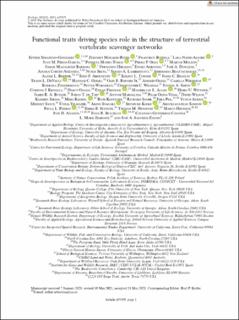Functional traits driving species role in the structure of terrestrial vertebrate scavenger networks
Sebastián-González, Esther; Morales-Reyes, Zebensui; Botella, Francisco; Naves-Alegre, Lara; Pérez-García, Juan M.; Mateo-Tomás, Patricia; Olea, Pedro P.; Moleón, Marcos; Barbosa, Jomar Magalhães; Hiraldo, Fernando; Arrondo, Eneko; Donázar, José A.; Cortés-Avizanda, Ainara; Selva, Nuria; Lambertucci, Sergio A.; Bhattacharjee, Aishwarya; Brewer, Alexis; Abernethy, Erin; Turner, Kelsey; Beasley, James C.; DeVault, Travis L.; Gerke, Hannah C.; Rhodes, Olin E.; Ordiz, Andres; Wikenros, Camilla; Zimmermann, Barbara; Wabakken, Petter; Wilmers, Christopher C.; Smith, Justine A.; Kendall, Corinne J.; Ogada, Darcy; Frehner, Ethan; Allen, Maximilian L.; Wittmer, Heiko U.; Butler, James R. A.; du Toit, Johan T.; Margalida, Antoni; Oliva-Vidal, Pilar; Wilson, David; Jerina, Klemen; Krofel, Miha; Kostecke, Rich; Inger, Richard; Per, Esra; Ayhan, Yunus; Sancı, Mehmet; Yılmazer, Ünsal; Inagaki, Akino; Koike, Shinsuke; Samson, Arockianathan; Perrig, Paula L.; Spencer, Emma E.; Newsome, Thomas M.; Heurich, Marco; Anadón, José D.; Buechley, Evan R.; Gutiérrez-Cánovas, Cayetano; Elbroch, L. Mark; Sánchez-Zapata, José A.
Peer reviewed, Journal article
Published version
Permanent lenke
https://hdl.handle.net/11250/2995468Utgivelsesdato
2021Metadata
Vis full innførselSamlinger
Sammendrag
Species assemblages often have a non-random nested organization, which in vertebrate scavenger (carrion-consuming) assemblages is thought to be driven by facilitation in competitive environments. However, not all scavenger species play the same role in maintaining assemblage structure, as some species are obligate scavengers (i.e., vultures) and others are facultative, scavenging opportunistically. We used a database with 177 vertebrate scavenger species from 53 assemblages in 22 countries across five continents to identify which functional traits of scavenger species are key to maintaining the scavenging network structure. We used network analyses to relate ten traits hypothesized to affect assemblage structure with the “role” of each species in the scavenging assemblage in which it appeared. We characterized the role of a species in terms of both the proportion of monitored carcasses on which that species scavenged, or scavenging breadth (i.e., the species “normalized degree”), and the role of that species in the nested structure of the assemblage (i.e., the species “paired nested degree”), therefore identifying possible facilitative interactions among species. We found that species with high olfactory acuity, social foragers, and obligate scavengers had the widest scavenging breadth. We also found that social foragers had a large paired nested degree in scavenger assemblages, probably because their presence is easier to detect by other species to signal carcass occurrence. Our study highlights differences in the functional roles of scavenger species and can be used to identify key species for targeted conservation to maintain the ecological function of scavenger assemblages

